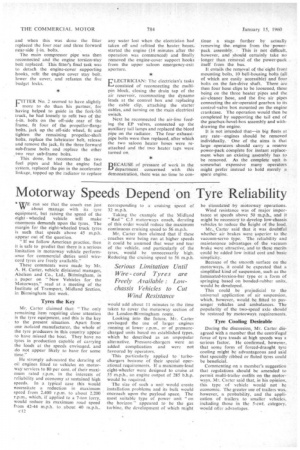Motorway Speeds Depend on Tyre Reliability
Page 50

If you've noticed an error in this article please click here to report it so we can fix it.
Serious Limitation Until Wire-cord Tyres are Freely Available; Lowchassis Vehicles to Cut Wind Resistance
WE can see that the coach can just VY about manage with its tyre equipment, but raising the speed of the eight wheeled vehicle will make enormous demands upon the tyres.. The margin for the eight-wheeled truck tyres is such that speeds above 45 m.p.h. appear out of the question.
"It we follow American practice, then it is safe to predict that there is a serious limitation in motorway vehicle performance for commercial duties until wirecord tyres are freely available."
These comments were made by Mr. A. It Carter, vehicle diyisional manager, Abelson and Co., Ltd., Bitiningham, in a paper on "New Vehicles for the Motorways," read at a meeting of the Institute of Transport, Midland Section. in Birmingham last week.
Tyres the Key
Mr. Carter claimed that: "The only remaining item requiring close attention is the tyre equipment, and this is the key to the present situation. Apart from one isolated manufacturer, the whole of the tyre producers in this country appear to have missed the boat. They have no tyres in production capable of carrying the loads at the speeds envisaged, and do not appear likely to have for some time."
He strongly advocated the derating of oil engines fitted to vehicles on motorway services to 80 per cent, of their maximum rated r.p.m. in the interests of reliability and economy at sustained high speeds. In a typical case this Would necessitate a reduction in maximum speed from 2.400 r.p.m. to about 2,200 r.p.m., which, if applied to a 7-ton lorry, would reduce its maximum road speed from 42-44 m.p.h. to about 40 m.p.h., corresponding to a cruising speed of 32 m.p.h.
Taking the example of the Midland " Red " C.5 motorways coach, derating of this order would reduce the maximum continuous cruising speed to 56 m.p.h.
Mr. Carter then claimed that if these coaches were being run at higher speeds it could be assumed that wear and tear of the vehicle, and particularly of the tyres, would be unnecessarily high. Reducing the cruising speed to 56 m.p.h.
would add about 11 minutes to the time taken to cover the motorway section of the .London-Birmingham route.
Looking into the future, Mr. Carter envisaged the use of larger engines running at lower r.p.m., or of pressurecharged units based on established types, which he described as an unpopular alternative. Pressure-chargers were an added complication and were not favoured by operators.
This particularly applied to turbochargers because of their special operational requirements. If a maximum-load eight-wheeler were designed to cruise at 55 m.p.h.. an engine output of 285 b.h.p. would be required.
The size of such a unit would create installation problems and its bulk would encroach upon the payload space. The most suitable type of power unit "on the horizon " appeared to be the gas turbine, the development of which might
be stimulated by motorway operations.
Wind resistance was of major importance at speeds above 50 m.p.h., and it might be necessary to develop low-chassis vehicles to reduce the height of the load.
Mr., Carter said that it was doubtful whether air brakes were superior to the vacuum-servo type. The reliability and maintenance advantages of the vacuum brake were attractive, and to these merits could be added low initial cost and basic simplicity.
Because of the smooth surface on the motorways, it could be expected that a simplified kind of suspension, such as the laminated-torsion-bar type or a form of springing based on bonded-rubber units, would be developed.
This could be prejudicial to the universal application of air suspension, which, however, would be fitted to passenger vehicles and ambulances. The popularity of the two-speed axle should be restored by motorways requirements.
Tyre Cooling Desirable
During the discussion, Mr. Carter disagreed with a member that the centrifugal force of tyre treads at high speeds was a serious factor. He confirmed, however, that some form of forced-draught tyre cooling might be advantageous and said that specially ribbed or fluted tyres could be beneficial.
Commenting on a member's suggestion that regulations should be amended to permit multi-trailer outfits on the motorways, Mr. Carter said that, in his opinion, this type •of vehicle would not be economic. The greater use of trailers was. however, a probability, and the application of trailers to smaller vehicles, including those in the 5-cwt. category. would offer advantages.












































































































